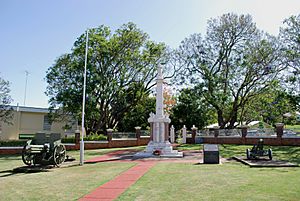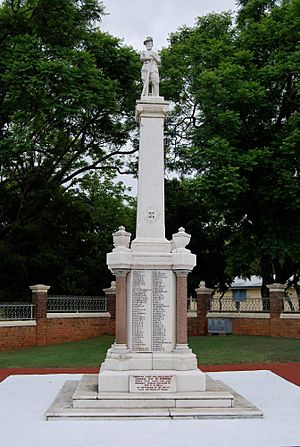Boonah War Memorial facts for kids
Quick facts for kids Boonah War Memorial |
|
|---|---|

War memorial in 2008
|
|
| Location | Park Street, Boonah, Scenic Rim Region, Queensland, Australia |
| Design period | 1919 – 1930s (interwar period) |
| Built | 1920–1922 |
| Official name: Boonah War Memorial and Memorial Park | |
| Type | state heritage (built) |
| Designated | 21 October 1992 |
| Reference no. | 600035 |
| Significant period | 1920– |
| Significant components | war trophy/ies, views to, pathway/walkway, memorial – park, memorial – soldier statue, flagpole/flagstaff, garden – bed/s, memorial – obelisk, fence/wall – perimeter, gate/s |
| Lua error in Module:Location_map at line 420: attempt to index field 'wikibase' (a nil value). | |
The Boonah War Memorial and Memorial Park is a special place in Boonah, Queensland, Australia. It was built between 1920 and 1922 to remember the brave local men who served in the First World War. This memorial is listed on the Queensland Heritage Register, which means it's an important historical site.
Contents
Remembering Our Heroes
The Boonah War Memorial is a very important memorial for the region. It was officially revealed on 31 July 1920. A special guest, the Prince of Wales (who later became King Edward VIII), was there for the event. He was visiting Boonah and the nearby Coochin Coochin Station.
The memorial is made of marble and granite. It was designed and built by F Williams and Company. It honors 374 local men from the Boonah area who served in the First World War. This includes 69 men who sadly lost their lives.
The town of Boonah grew to support the large farms in the area. Before the town was built, supplies came by bullock cart from Ipswich. When the railway reached Dugandan in 1887, more people moved to the area. This helped Boonah to grow and become a busy town.
On 19 May 1920, the first stone for the memorial was laid by General Sir William Birdwood. The community raised money to build the monument. It cost about £600, which was a lot of money back then! The special park around the memorial opened on Anzac Day in 1922. A war hero and politician named Captain Arnold Wienholt unveiled the fence.
Why War Memorials Are Important
Before the First World War, Australia didn't have many public monuments. But after the war, memorials became our first national monuments. They showed how much the war affected our young country. Australia lost 60,000 people from a population of about 4 million. This means one out of every five Australians who served died. No other war has had such a big impact on Australia.
Even before the war ended, people started building memorials. They were a way to show national sadness. For those who built them, these memorials were like sacred graves. They were substitute graves for Australians whose bodies were buried in battlefields far away in Europe and the Middle East. The word "cenotaph," often used for war memorials, means "empty tomb."
Australian war memorials are special because they don't just remember those who died. Australians were proud that their first big national army was made up entirely of volunteers. These men were honored whether they died or not. Many memorials honor everyone from a town who served, not just those who died. This helps us understand how much communities were involved in the war.
Australian war memorials also show us about our country's loyalties at the time. They show the skills of local stonemasons and builders. In Queensland, statues of soldiers were very popular. In other states, tall, pointed monuments called obelisks were more common.
Many First World War memorials have been updated to include later wars. Some have been moved or repaired in ways that changed their original look.
The "Digger" Statue
Even though there are many types of memorials in Queensland, the "digger" statue is the most common. Communities often chose these statues because they showed the ANZAC Spirit. They represented what people thought was the ideal Australian: loyal, brave, young, innocent, and strong. The "digger" statue was very popular in Queensland. Other states had groups of artists and architects who advised on memorial designs. These experts didn't always like the "digger" statue.
Most statues were made by local stone companies. However, some were made by artists or brought in from other places. The Boonah memorial was designed and built by F Williams and Company, a well-known company from Ipswich. The "digger" statue on the Boonah Memorial stands in a relaxed way, which was typical for statues made by Williams.
What the Memorial Looks Like
The First World War Memorial is in a special park in Boonah. It is located where Park Street and Yeates Street meet. A strong brick and wrought iron fence surrounds the park. The fence has white concrete parts. There are wrought iron gates at the front and back corners. These gates have white pillars with round tops. All the wrought iron is painted silver.
The park is designed in a formal way, with a path running from the corner of Park and Yeates Streets. A red concrete path leads to the memorial. It has white concrete edges. The memorial is surrounded by neat garden beds.
Next to the memorial are two war trophies. A flagpole stands on the south-western side. The larger trophy is a German FK96 n.A. field gun. The people of Boonah bought this gun in 1921. They had turned down an earlier offer of two captured German machine guns. This means Boonah was the only Australian town to buy its own Great War trophy gun!
The memorial itself is mostly made of Ulam marble. It has a pedestal (a base) with a tall, pointed obelisk on top. On the very top is a digger statue.
The memorial sits on a marble base with three steps. The first stone laid for the memorial is on the front of the top step.
Above the base is the pedestal. It has square parts at each corner. These parts are bases for red polished granite columns. These columns have marble tops and bottoms. The columns support a large cornice (a decorative top part). On top of the cornice are four marble urns. In the middle of the columns are marble plates. These plates have the names of the 374 local men who served in the First World War. The names of the 69 men who died are on the front face. The back face has the names of nurses and chaplains.
From the center of the pedestal rises the marble obelisk. It is about 20 feet (6.1 m) high and gets slightly narrower towards the top. It has a wreath carved around the dates of the war on the front.
On top of the obelisk is the digger statue. It is a little smaller than life-sized. The soldier stands in a relaxed pose. His head is bowed, and his hands rest on his rifle, which is upside down. A tree stump behind his left leg helps support the statue.
Why It's a Heritage Site
The Boonah War Memorial and Memorial Park was added to the Queensland Heritage Register on 21 October 1992. This means it's recognized as an important historical place for several reasons:
- Showing Queensland's History: War memorials show how Queensland's history unfolded. They represent a common theme that affected most communities. They also show a time of strong Australian pride and nationalism, especially during and after the First World War. These monuments are unique records and show what was popular in design between the wars.
- A Great Example of Its Kind: Built in 1920, this memorial is a major regional site. It shows the main features of a monument built to remember a big historical event. It uses good materials and design. As a "digger" statue, it's a great example of the most popular type of memorial in Queensland.
- Beautiful and Important: The memorial and its park are beautiful because of their excellent design and materials. It's also a very noticeable landmark in the town. It's special because it's a war memorial that is still part of its original, well-preserved park setting.
- Strong Community Connection: The memorial has a strong connection with the community. It shows how much a major historical event affected them. It also has a special link to the Ipswich masonry company F Williams and Company, showing their important work.


